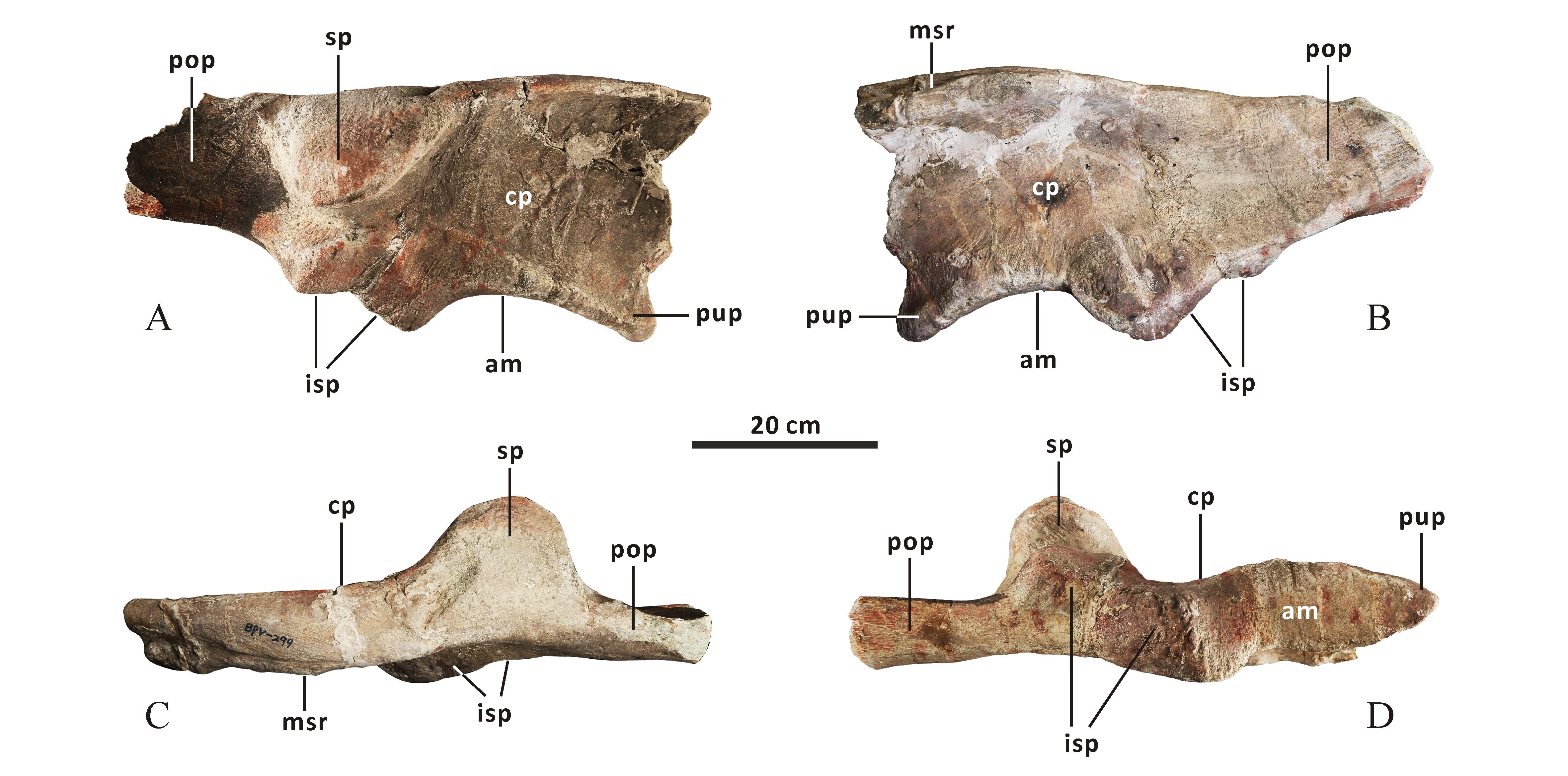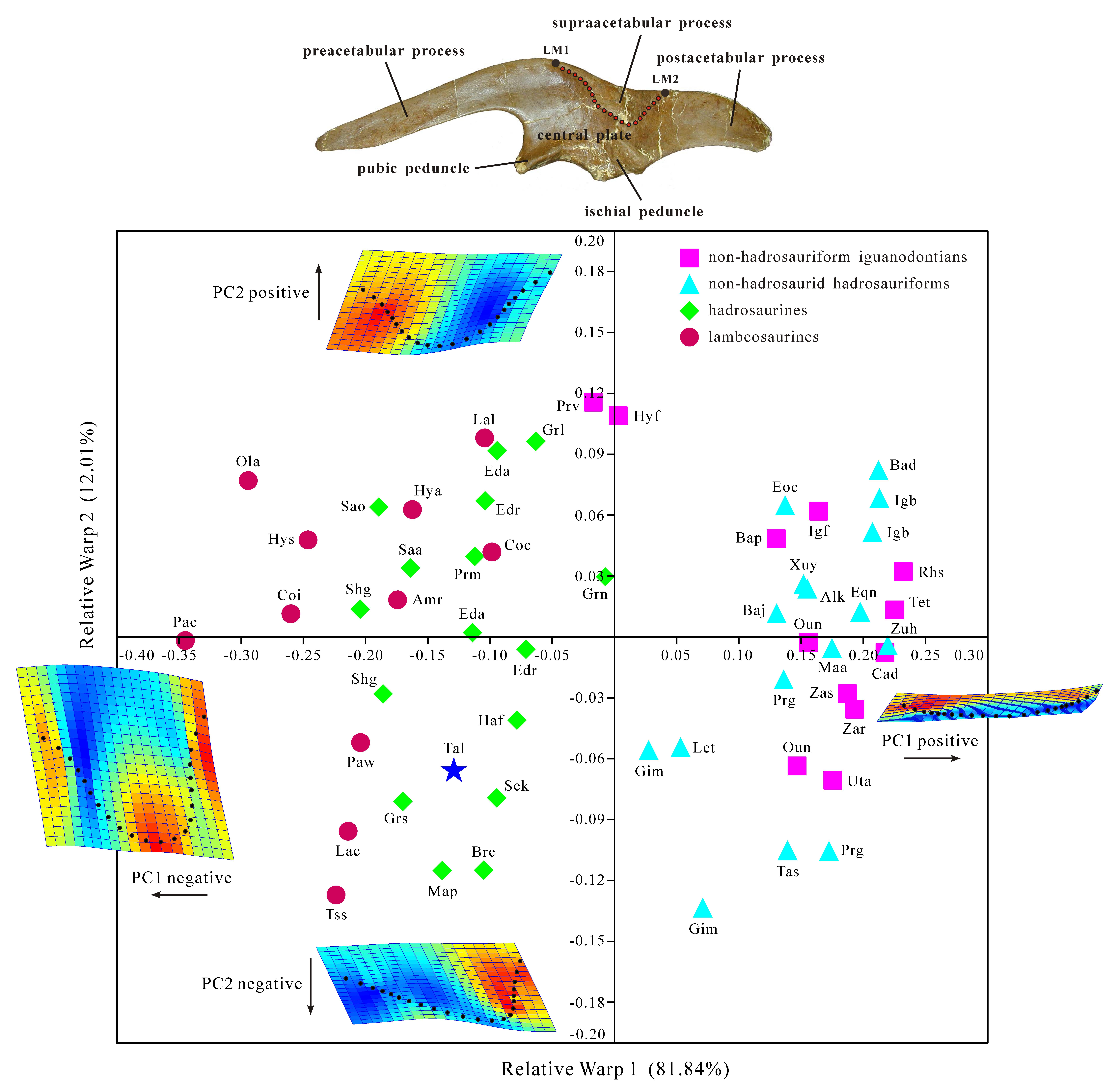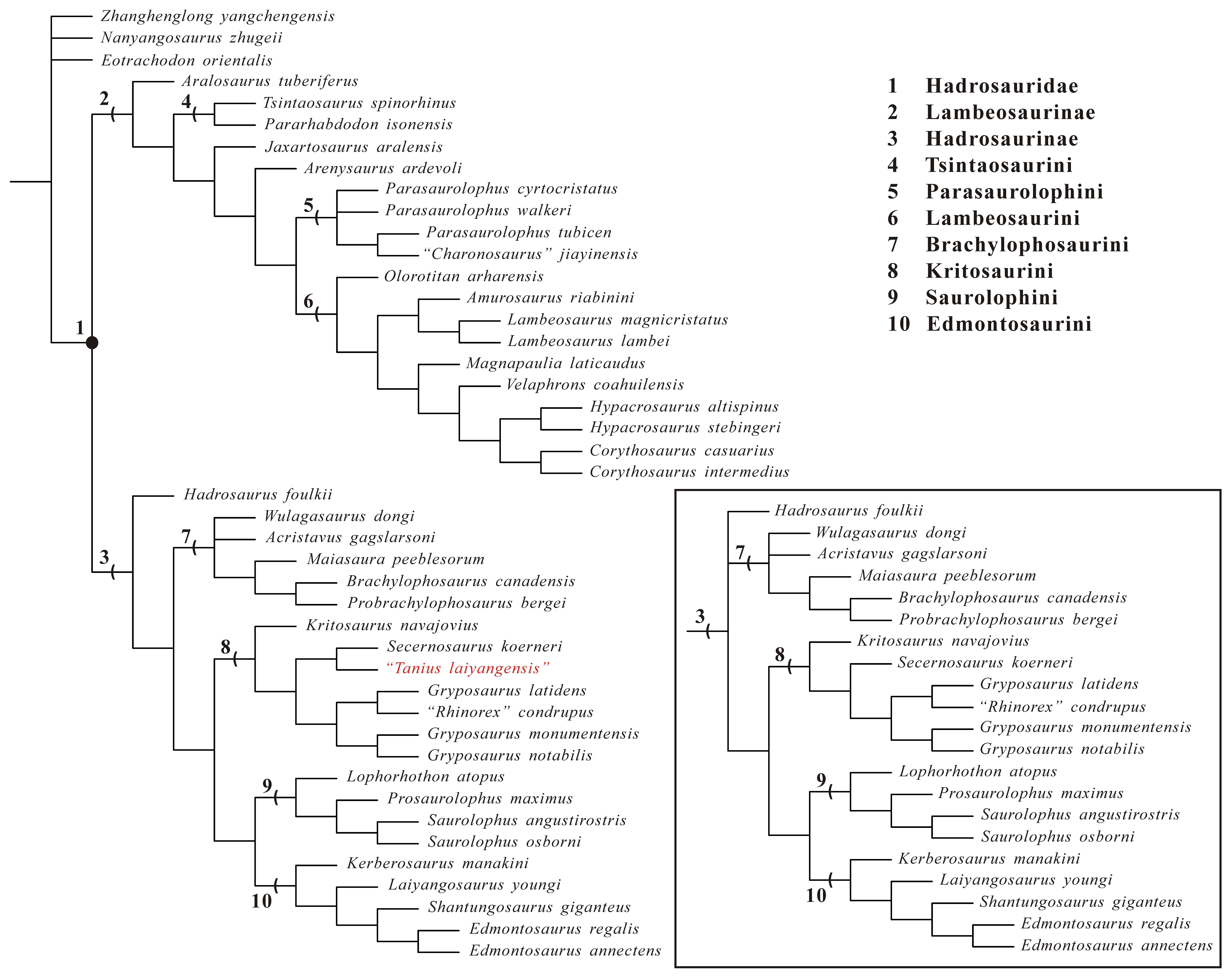中国山东上白垩统莱阳谭氏龙的骨学重新评估与分类学修订
发布时间:2020年12月30日
国际解剖学与古生物学专业杂志解剖学记录(The Anatomical Record)于2020年上半年在线发表了题为“中国山东上白垩统莱阳谭氏龙的骨学重新评估与分类学修订”的研究成果。该研究工作由北京自然博物馆和诸城市恐龙博物馆的研究人员共同完成。此项研究受国家自然科学基金、北京市自然科学基金、北科院人才项目以及北京市新世纪百千万人才工程项目资助。
该论文系统阐述和评估了中国最早命名的鸟臀类恐龙—谭氏龙。从1929年开始,这一类群的三个属,包括中国谭氏龙、金刚口谭氏龙和莱阳谭氏龙(Tanius laiyangensis),在中国山东省的上白垩统王氏群被陆续发现,并被错误地认定为鸭嘴龙亚科的成员。伴随着“中国谭氏龙的分类学地位处于鸭嘴龙科之外”这一观点逐渐达成共识,金岗口谭氏龙和莱阳谭氏龙化石材料的分类学归属变得有很大的疑问。北京自然博物馆古生物学科研团队对产自于山东东北部金刚口组的莱阳谭氏龙唯一化石材料开展了全面的分类学修订。通过比较解剖学和系统发育学研究,我们发现了莱阳谭氏龙同鸭嘴龙亚科之间较近的亲缘关系:这一属种的肠骨保留了一个沿背腹向较窄的中央板,同鸭嘴龙亚科的大多数类群十分相似;支序分析的结果显示了该类群与北美洲小贵族龙族(Kritosaurini)之间的紧密亲缘性。
为了更加客观和精确地识别莱阳谭氏龙的分类学地位和有效性,北京自然博物馆科研人员对禽龙类的肠骨上髋臼突的外侧轮廓标志点和半标志点数据集执行了相对扭曲分析。几何形态测量分析的结果显示:第一和第二相对扭曲轴代表了93.85%的总体形状变异。其中,从主轴的积极向消极范围移动,第一相对扭曲的总体变异(81.84%)同上髋臼突的背腹深度的增加密切相关;沿积极方向偏移,肠骨上髋臼突的外侧轮廓趋向于浅弓形状;而向消极方向移动,该结构的外侧轮廓逐渐转变为深U形。与非鸭嘴龙科禽龙类样本不同,所有鸭嘴龙科的样本都聚集在第一相对扭曲轴的消极范围内。从积极向消极范围偏移,第二相对扭曲的总体变异(12.01%)同上髋臼突腹侧顶点的向后移动有着紧密的联系。沿着第二相对扭曲轴的积极方向移动,上髋臼突展示了一个几乎对称的外侧轮廓;相比之下,当朝向消极范围时,上髋臼突的外侧轮廓趋于向后偏斜和不对称。莱阳谭氏龙的数据点被限定在两个相对扭曲轴的消极范围内,并被鸭嘴龙科的样本数据簇完全包围,特别是同小贵族龙族的样本点十分接近。该几何形态测量分析的结果同系统发育分析构建的布局十分相似,均展现了莱阳谭氏龙零散化石材料(包括不完整的肠骨和荐椎)的小贵族龙族亲缘性。来自不同方向证据链的高度吻合显著增加了这一研究成果的可信度。
Osteological Re-assessment and Taxonomic Revision of “Tanius laiyangensis” (Ornithischia: Hadrosauroidea) from the Upper Cretaceous of Shandong, China
YU-GUANG ZHANG,1* KE-BAI WANG,2 SHU-QING CHEN,2 DI LIU,1 AND HAI XING1*
1Beijing Museum of Natural History, Beijing Academy of Science and Technology, Beijing, People’s Republic of China
2Zhucheng Dinosaur Museum, Dinosaur Research Center of Zhucheng, Zhucheng, Shandong, People’s Republic of China
*Correspondence to: Yu-Guang Zhang and Hai Xing, E-mail: xinghai@bmnh.org.cn
Abstract:Tanius is the earliest named ornithischian genus from China. Since 1929, three species of this genus, namely T. sinensis (the type species), “T. chingkankouensis” and “T. laiyangensis”, have been reported based on remains from the Wangshi Group of Shandong, China, and were previously recognized as hadrosaurines. Following the recent achievement of consensus on the phylogenetic placement of T. sinensis outside Hadrosauridae, the assignments of the “T. chingkankouensis” and “T. laiyangensis” material of hadrosaurid origin to the genus Tanius become problematic. Related taxonomic issues of “T. laiyangensis” therefore need re-appraisals. Here we provide an overall taxonomic revision of “T. laiyangensis” from the Jingangkou Formation of northeast Shandong, by means of approaches of comparative anatomy, phylogeny and geometric morphometrics. Our osteological comparisons confirm the hadrosaurine affinity of “T. laiyangensis”, given the presence of a suite of characters largely typical of Hadrosaurinae in the single specimen (i.e., a nearly complete sacrum and a partial right ilium), including a dorsoventrally narrow central plate of the ilium with the depth/length ratio less than 0.80. In the proposed phylogenetic framework, “T. laiyangensis” is inferred to be a member of Kritosaurini within Hadrosaurinae, as the sister taxon to Secernosaurus koerneri. The relative warp analysis on the lateral outline of the supraacetabular process also reveals a close resemblance of shape between the two species. Based on these different lines of evidence and considering no identification of any diagnostic characters from the specimen, we argue that the “T. laiyangensis” material comes from an indeterminate kritosaurin hadrosaurine in Asia.
Key words: “Tanius laiyangensis”; taxonomic revision; anatomy; relative warp analysis; maximum parsimony analysis; Kritosaurini; Hadrosaurinae

图1 小贵族龙族未定属种(原名为莱阳谭氏龙)的不完整右肠骨(张玉光供图)

图2 反映肠骨上髋臼突外侧轮廓形状变异状况的几何形态相对弯曲图(张玉光供图)

图3 针对莱阳谭氏龙化石材料(现归入小贵族龙族未定属种)的系统发育位置推测(张玉光供图)